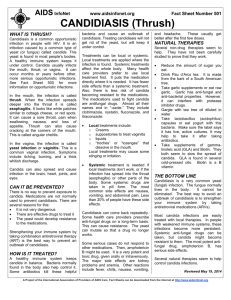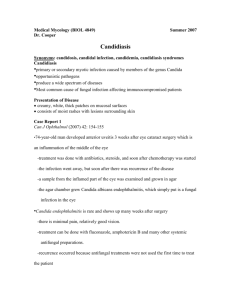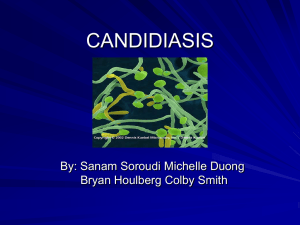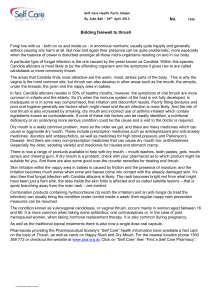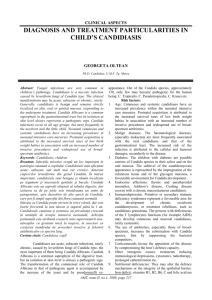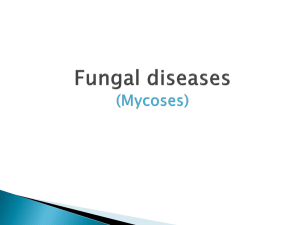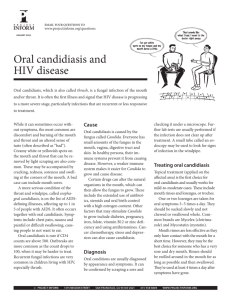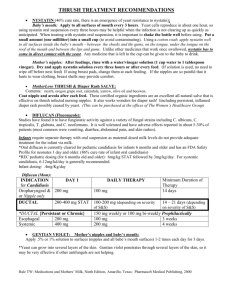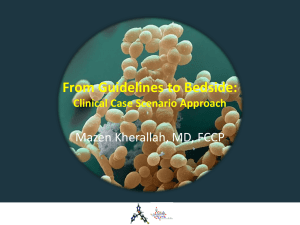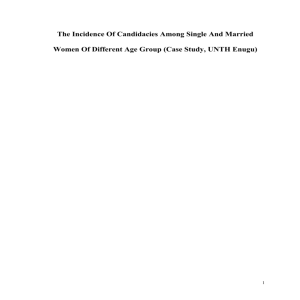Oral Candidiasis - College Of Dental Hygienists of Ontario
advertisement
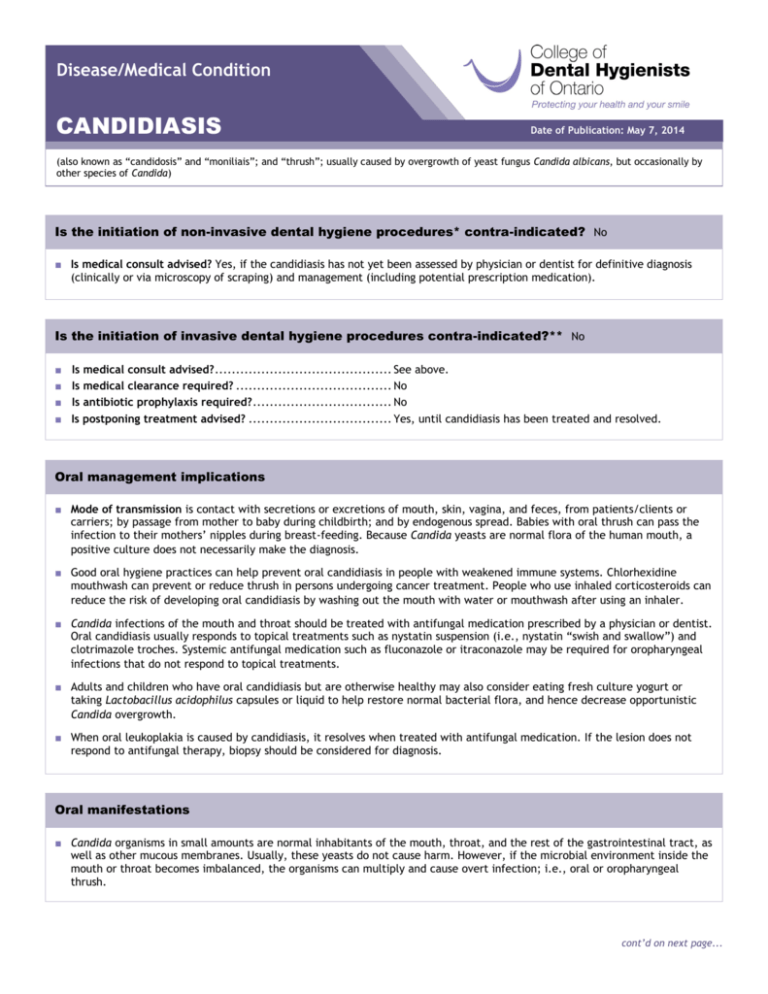
Disease/Medical Condition CANDIDIASIS Date of Publication: May 7, 2014 (also known as “candidosis” and “moniliais”; and “thrush”; usually caused by overgrowth of yeast fungus Candida albicans, but occasionally by other species of Candida) Is the initiation of non-invasive dental hygiene procedures* contra-indicated? No ■ Is medical consult advised? Yes, if the candidiasis has not yet been assessed by physician or dentist for definitive diagnosis (clinically or via microscopy of scraping) and management (including potential prescription medication). Is the initiation of invasive dental hygiene procedures contra-indicated?** No ■ ■ ■ ■ Is medical consult advised? .......................................... See above. Is medical clearance required? ..................................... No Is antibiotic prophylaxis required? ................................. No Is postponing treatment advised? .................................. Yes, until candidiasis has been treated and resolved. Oral management implications ■ Mode of transmission is contact with secretions or excretions of mouth, skin, vagina, and feces, from patients/clients or carriers; by passage from mother to baby during childbirth; and by endogenous spread. Babies with oral thrush can pass the infection to their mothers’ nipples during breast-feeding. Because Candida yeasts are normal flora of the human mouth, a positive culture does not necessarily make the diagnosis. ■ Good oral hygiene practices can help prevent oral candidiasis in people with weakened immune systems. Chlorhexidine mouthwash can prevent or reduce thrush in persons undergoing cancer treatment. People who use inhaled corticosteroids can reduce the risk of developing oral candidiasis by washing out the mouth with water or mouthwash after using an inhaler. ■ Candida infections of the mouth and throat should be treated with antifungal medication prescribed by a physician or dentist. Oral candidiasis usually responds to topical treatments such as nystatin suspension (i.e., nystatin “swish and swallow”) and clotrimazole troches. Systemic antifungal medication such as fluconazole or itraconazole may be required for oropharyngeal infections that do not respond to topical treatments. ■ Adults and children who have oral candidiasis but are otherwise healthy may also consider eating fresh culture yogurt or taking Lactobacillus acidophilus capsules or liquid to help restore normal bacterial flora, and hence decrease opportunistic Candida overgrowth. ■ When oral leukoplakia is caused by candidiasis, it resolves when treated with antifungal medication. If the lesion does not respond to antifungal therapy, biopsy should be considered for diagnosis. Oral manifestations ■ Candida organisms in small amounts are normal inhabitants of the mouth, throat, and the rest of the gastrointestinal tract, as well as other mucous membranes. Usually, these yeasts do not cause harm. However, if the microbial environment inside the mouth or throat becomes imbalanced, the organisms can multiply and cause overt infection; i.e., oral or oropharyngeal thrush. cont’d on next page... Disease/Medical Condition CANDIDIASIS (also known as “candidosis” and “moniliais”; and “thrush”; usually caused by overgrowth of yeast fungus Candida albicans, but occasionally by other species of Candida) Oral manifestations (cont’d) ■ Candida infections of the mouth and throat are uncommon among healthy adults. ■ Oral thrush occurs most frequently in babies less than one month old (up to 7% prevalence), the elderly, and persons with immunodeficiency. Other factors associated with overgrowth of Candida species include HIV/AIDS (between 9% and 31% prevalence); cancer chemotherapy; organ transplantation (and associated use of immunosuppressive drugs); diabetes; corticosteroid use (systemically, as well as topically via oral inhalation — e.g., for asthma management); dentures; broadspectrum antibiotic use; xerostomia; pregnancy (due to hormonal changes); oral contraceptive use; smoking; hypoparathyroidism; bone marrow malignancies; and primary T-lymphocyte deficiency. ■ The most common sign of oral candidiasis is creamy white, slightly raised patches or plaques on the tongue and other oral mucous membranes, including the buccal mucosa, hard and soft palates, tonsils, and gums. The lesions may bleed slightly when scraped or during tooth brushing. ■ Other signs and symptoms include redness and/or pain in the affected areas (especially in erythematous candidiasis); difficulty swallowing (especially if there is also throat involvement); and cracking at the corners of the mouth (i.e., angular cheilitis). In pseudomembranous candidiasis, a white, curdlike (“cottage cheese”) material is present on the mucosal surface. Chronic hyperplastic candidiasis (also known as candidal leukoplakia and hypertrophic candidiasis) appears as a white lesion which does not wipe off the mucosa. ■ In denture stomatitis (also known as chronic atrophic candidiasis), erythematous change is limited to the mucosa covered by a full or partial denture. The lesions may vary from petechiae-like to more granular and generalized. Most common on the palate and alveolar ridge, denture stomatitis is asymptomatic and is usually discovered by the dental hygienist or dentist during a routine examination. ■ Median rhomboid glossitis (a.k.a. central papillary atrophy) is sometimes associated with candidiasis. This condition appears as an erythematous, often rhombus-shaped, flat-to-raised area on the mid-line of the posterior dorsal tongue. Candida yeast are present in some lesions, which disappear with antifungal treatment. Related signs and symptoms ■ Candida infection is not restricted to the mouth and pharynx. It can occur in other parts of the body, causing fungal diaper rash in infants or vaginal yeast infections in women. Infants with oral thrush often have concurrent fungal diaper rash. ■ Untreated oropharyngeal Candida infections can lead to invasive candidiasis in susceptible persons, including spread to the esophagus, lungs, liver, and skin. This occurs most often in immunocomprised persons. Fever may be present. ■ Candida overgrowth in the esophagus is called Candida esophagitis, or esophageal candidiasis. It is associated with pain and difficulty swallowing. In particularly severe cases, intravenous antifungal therapy may be required. ■ Chronic mucocutaneous candidiasis is a severe form of candidiasis, which typically occurs in patients/clients who are severely immunocompromised. The patient/client has skin lesions as well as chronic oral and genital mucosal candidiasis. The nails and skinfolds are usually involved. ■ Breast-feeding women whose breasts are infected with Candida may experience red, sensitive, or itchy nipples; shiny or flaky skin on the areola; pain during nursing; painful nipples between feedings; and stabbing pains within the breast. Both mother and child should be treated with appropriate antifungal therapy in order to break the cycle of passing Candida back and forth between mother’s breasts and baby’s mouth. cont’d on next page... 2 Disease/Medical Condition CANDIDIASIS (also known as “candidosis” and “moniliais”; and “thrush”; usually caused by overgrowth of yeast fungus Candida albicans, but occasionally by other species of Candida) References and sources of more detailed information ■ US Centers for Disease Control and Prevention http://www.cdc.gov/fungal/candidiasis/ ■ Mayo Clinic http://www.mayoclinic.com/health/oral-thrush/DS00408 ■ M. Darby (ed.) and M. Walsh (ed.). Dental Hygiene: Theory and Practice. St. Louis: Saunders Elsevier; 2010. ■ OAC Ibsen and J Andersen Phelan. Oral Pathology For The Dental Hygienist (6th edition). St. Louis: Saunders Elsevier; 2014. ■ D. Heymann (ed.). Control of Communicable Disease Manual (18th edition). Baltimore: American Public Health Association; 2004. * Includes oral hygiene instruction, fitting a mouth guard, taking an impression, etc. ** Ontario Regulation 501/07 made under the Dental Hygiene Act, 1991. Invasive dental hygiene procedures are scaling teeth and root planing, including curetting surrounding tissue. Date: February 2, 2014 69 Bloor St. E, Suite 300, Toronto, ON M4W 1A9 t: 416-961-6234 ● tf: 1-800-268-2346 ● f: 416-961-6028 ● www.cdho.org 3
